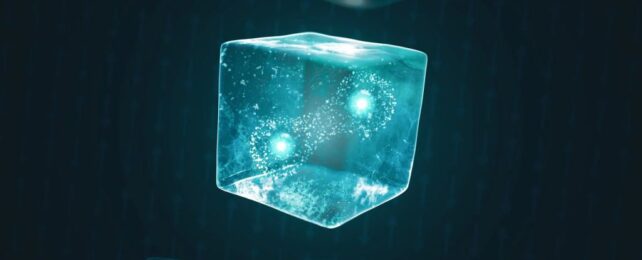
Understand that I expect neutron pairs which we cannot detect. We needed electron pairs obviously linked together in order to exist. Now we discover they can exist at a much higher temperature that expected.
We could be getting closer to real super conductivity without the horrible hardware.
We know that a neutron pair exists across all temperature ranges we can deal with. Can we pull the same thing off with neutral electron pairs? Are these pairs actually producing magnetism? both need complex metal alloys to naturally set up?
Just how do free electrons interact with neutral electron pairs?
Superconductor Feature Seen Operating at Temperatures Once Thought Impossible
16 August 2024
Artist's impression of a paired electrons. (SLAC National Accelerator Laboratory)
A crucial feature of superconductivity has just been observed at much higher temperatures than scientists had thought possible.
Physicists have found electrons pairing up in the way they do in superconducting materials in an unexpected material, above the incredibly cold temperatures similar materials permit superconductivity to occur.
Superconductivity decribes the way electrons move through a material without any resistance and subsequent energy loss. We've observed this phenomenon in many different materials, but there's a catch. We only seem to be able to make it happen at extremely low temperatures, close to absolute zero (-273.15 degrees Celsius, or -460 degrees Fahrenheit), or slightly less cold temperatures with a lot of pressure.
Although the electrons in the newly tested materials didn't achieve resistance-free flow, their pairing is a critical step required for it to occur, potentially leading to superconductivity that won't need big equipment.
"The electron pairs are telling us that they are ready to be superconducting, but something is stopping them," says physicist Ke-Jun Xu of Stanford University. "If we can find a new method to synchronize the pairs, we could apply that to possibly building higher temperature superconductors."
The material is a layered, copper-based crystal, or cuprate, called neodymium cerium copper oxide (Nd2−xCexCuO4). At low temperatures, the crystal exhibits superconductivity, yet it becomes significantly more resistant at higher temperatures.
Now, in order for superconductivity to kick in, electrons need their quantum identity to be entangled, turning them into as what's known as a Cooper pair. Only then can they weave smoothly through the atomic forest with zero effort.
Conventional superconductors, which exhibit superconductivity below around 25 Kelvin (-248 degrees Celsius, or -415 degrees Fahrenheit), entangle their electrons through vibrations in the underlying material.
Cuprates are unconventional superconductors, exhibiting superconductivity at temperatures up to 130 Kelvin. Scientists think that there is another mechanism responsible for electron pairing in these materials, yet the exact process is still somewhat murky.
The neodymium cerium copper oxide Xu and his team studied is like a conventional superconductor in that it doesn't exhibit the phenomenon above 25 Kelvin, which allows them to study the stages of superconductivity. As the electrons entangle, they are less resistant to being ejected from the material as the temperature rises; that is, the material loses energy at a lower rate. This is known as the pairing gap.
The team observed their material retaining more energy at temperatures up to 140 Kelvin (-133 degrees Celsius, or -207 degrees Fahrenheit) – far higher than the 25 Kelvin superconductivity transition temperature. This suggests that the electrons form Cooper pairs at pretty high temperatures, relatively speaking.
It's still not clear what is inducing the pairing. And the specific material might not be the one to bring us to room temperature superconductivity. But it could be a means of finding both answers, and the material, in the future.
Superconductivity at ambient temperatures is kind of a big deal. Imagine 100 percent energy efficiency – we could reduce the size of the circuitry required to transport electrons, packing more power into a smaller space for faster, cheaper technology.
But cracking the code has been very hard. We've had a few claimed breakthroughs, such as the much-hyped LK-99, but all of them have amounted to nothing.
Progress is likely to be more incremental – such as observing some of the features of superconductivity in higher-temperature materials, working out why it happens, advancing step by painstaking step.
"Our findings open a potentially rich new path forward," says physicist Zhi-Xun Shen of Stanford University.
"We plan to study this pairing gap in the future to help engineer superconductors using new methods. On the one hand, we plan to use similar experimental approaches at SSRL to gain further insight into this incoherent pairing state. On the other hand, we want to find ways to manipulate these materials to perhaps coerce these incoherent pairs into synchronization."
The research has been published in Science.
No comments:
Post a Comment